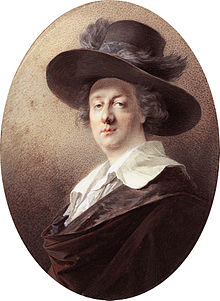Joseph Barth (physician)

Joseph Barth (born October 18, 1745 , according to Cassar October 28, 1746 , in Valletta , Malta , † April 7, 1818 in Vienna ) was an Austrian physician .
He was the illegitimate child of Niccolò and Maddalena Sciberras.
But he must have enjoyed a good education, because he studied in Rome and Vienna, where he received his doctorate in 1772. He then learned from the French ophthalmologist Baron Michael de Wenzel the Elder (1724–1790). Barth saw his profession and his knowledge more as a source of money and only at the express request of Emperor Josef II was he induced to teach an already trained doctor against the assurance of a significant fee.
In 1773 he became lecturer in ophthalmology and fine anatomy in Vienna, and in 1774 he was already a full professor. In 1776 he became the imperial personal physician . He founded a private ophthalmological institute and performed around 3,000 cataract operations . Johann Adam Schmidt and Georg Joseph Beer were his students.
He resigned his professorship in 1791 and devoted himself to art. He bought numerous pieces and for a time was the owner of the torso of Ilioneus , which he sold to the later King Ludwig I in 1814 for 30,000 guilders . Alexander von Humboldt met Barth in Vienna in 1797 and valued his erudition.
The painter Tommaso Benedetti was his adopted son.
Works
- The beginnings of muscle theory. Vienna: Anton Gassler, 1786.
- Joseph Bart's ... Muscle theory: according to the two main relationships, their position and connection with one another, as well as according to their general and particular functions; with 53 copper plates carefully designed according to nature. 2nd edition Vienna: Lechner, 1819.
literature
- Constantin von Wurzbach : Barth, Joseph . In: Biographisches Lexikon des Kaiserthums Oesterreich . 1st part. University book printer L. C. Zamarski (formerly JP Sollinger), Vienna 1856, p. 166 f. ( Digitized version ).
- August Rothmund: Barth, Josef . In: Allgemeine Deutsche Biographie (ADB). Volume 2, Duncker & Humblot, Leipzig 1875, p. 100.
- Karl Schadelbauer: Barth, Josef. In: New German Biography (NDB). Volume 1, Duncker & Humblot, Berlin 1953, ISBN 3-428-00182-6 , p. 604 f. ( Digitized version ).
- Barth Joseph. In: Austrian Biographical Lexicon 1815–1950 (ÖBL). Volume 1, Verlag der Österreichischen Akademie der Wissenschaften, Vienna 1957, p. 51.
- P. Cassar: Ophthalmic Surgeon Joseph Barth (1746-1818) . University of Malta (1982).
- Theoretical-practical handbook of surgery including syphitic and eye diseases in alphabetical order, Volume 2, p.732
- Encyclopedia History of Medicine, Volume 1, page 147
Individual evidence
- ↑ sedge leaves. A Journal of Life, Literature and Art, Volume 1, January 1815, [1]
- ^ Hanno Beck: Alexander von Humboldt. Vol. I: From the educational trip to the research trip 1769-1804 . Steiner, Wiesbaden 1959, p. 95 f .
| personal data | |
|---|---|
| SURNAME | Barth, Joseph |
| BRIEF DESCRIPTION | Austrian medic |
| DATE OF BIRTH | uncertain: October 18, 1745 or October 28, 1746 |
| PLACE OF BIRTH | Valletta |
| DATE OF DEATH | April 7, 1818 |
| Place of death | Vienna |